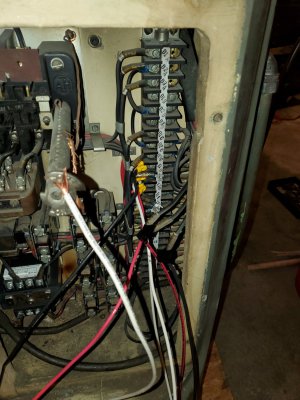Lots to report and show (when I get time to take some pics!). I got the wiring working a long time ago, powerfeeds and all work at the same time and it's been a dream to use honestly. I would have kept the thread updated but got too carried away with using the thing, plus the day job getting busy too. I wired up two huge boxes for the VFDs with lots of protection, fuses and circuit breakers and a contactor and all, and even some input noise filters and AC reactors per the VFD manual, though these are almost certainly unnecessary in my case. If I remember correctly, the problem with the powerfeed VFD was one of the original built-in switches downstream of the VFDs, on the control panel on the side of the mill.
Anyhow, I've gotten a few projects done with it (added a DRO, then I made a complete pantograph attachment for the mill most recently, lots of precision hole drilling in chuck backplates and such, and current project is die blocks out of D2 for forming stamps). The only issue I'm still having is that damn toothed belt being so tight. It still won't go onto the lower set of cogs even when pryed on with screwdrivers and a large prybar. This is after loosening both the v-belt tensioner (the screw in the back that moves the v-belt jackshaft forward and aft) and also undoing the 2 SHCS holding the belt housing down to the head, then sliding that forward to release the tension on the lower jackshaft holding the rear cogs.
I have been making due with the belt in one position for years now, on the 860 rpm position (slowest v-belt setting and high timing-belt setting) which is the slowest I can get with the timing belt stuck where it is. The VFD can get me down to ~200rpm just fine, but there's so little torque there. In making my pantograph attachment out of aluminum, it didn't matter because even that little amount of torque at ~20Hz was enough to take .050" passes with a 1.5" shell mill in aluminum at a 2"/min feedrate. Now that I am tackling D2, the spindle motor is stalling in the (annealed) D2 block with a mere .020" pass, with the slowest feed rate too (0.75"/min I believe) and carbide tooling. I may be able to get by using a sharper HSS shell mill, but I'd really like the ability to use my carbide facemill in things other than aluminum.
My ask: Can anyone with a 1-B that can go out and take a look at the info written on their toothed belt? Mine is a 270H075, a 27" long, 54-tooth, 3/4" wide belt. It also has the label "Synchro-cog Timing 270H" on the other side, with what looks like a serial number 4703 on it next to an hourglass figure. The belt almost seems barely too wide to sit on the bottom toothed cog, and definitely seems too short given that no amount of slack will let it get on the lower cogs. What belts do you guys have on your 1-Bs?


